
eBook - ePub
House of Print
A modern printer's take on design, colour and pattern
Molly Mahon
This is a test
Compartir libro
- 160 páginas
- English
- ePUB (apto para móviles)
- Disponible en iOS y Android
eBook - ePub
House of Print
A modern printer's take on design, colour and pattern
Molly Mahon
Detalles del libro
Vista previa del libro
Índice
Citas
Información del libro
A modern, stylish and practical exploration of the traditional craft of block printing.
For self-taught textile designer Molly Mahon, there is something special about block printing that has stood the test of time. From the initial design process, through to the carving of the block, the mixing of the colour and the actual printing process, Molly has always found printing to be meditative.
This book enables readers to explore this ancient craft through Molly's contemporary designs and the influences that inspire her use of pattern and colour, before teaching them practical skills and potential ways to transform their creations into beautiful homeware.
The book is divided into three main sections:
A Modern Block Printer:
Preguntas frecuentes
¿Cómo cancelo mi suscripción?
¿Cómo descargo los libros?
Por el momento, todos nuestros libros ePub adaptables a dispositivos móviles se pueden descargar a través de la aplicación. La mayor parte de nuestros PDF también se puede descargar y ya estamos trabajando para que el resto también sea descargable. Obtén más información aquí.
¿En qué se diferencian los planes de precios?
Ambos planes te permiten acceder por completo a la biblioteca y a todas las funciones de Perlego. Las únicas diferencias son el precio y el período de suscripción: con el plan anual ahorrarás en torno a un 30 % en comparación con 12 meses de un plan mensual.
¿Qué es Perlego?
Somos un servicio de suscripción de libros de texto en línea que te permite acceder a toda una biblioteca en línea por menos de lo que cuesta un libro al mes. Con más de un millón de libros sobre más de 1000 categorías, ¡tenemos todo lo que necesitas! Obtén más información aquí.
¿Perlego ofrece la función de texto a voz?
Busca el símbolo de lectura en voz alta en tu próximo libro para ver si puedes escucharlo. La herramienta de lectura en voz alta lee el texto en voz alta por ti, resaltando el texto a medida que se lee. Puedes pausarla, acelerarla y ralentizarla. Obtén más información aquí.
¿Es House of Print un PDF/ePUB en línea?
Sí, puedes acceder a House of Print de Molly Mahon en formato PDF o ePUB, así como a otros libros populares de Art y Art général. Tenemos más de un millón de libros disponibles en nuestro catálogo para que explores.
Información
Categoría
ArtCategoría
Art généralPROJECTS
Napkins
Tablecloth
Book cover
Lampshade
Cushion
More printing projects
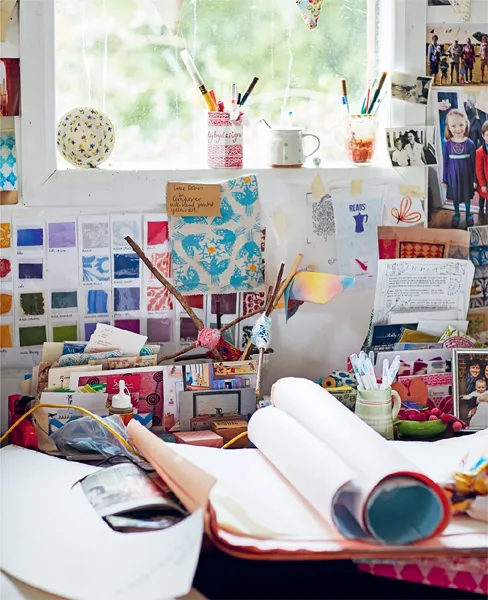
So many things can be made with printed fabric and paper. Here I have chosen five of my favourite items to get you started. I often print onto existing items, but I have included basic making-up guides if you would like to create your items from scratch. While the same printing technique is used to create the foundation of each project, the tools required and the way in which the designs are created have been varied to illustrate the incredible versatility of the block print process (and the information provided in the previous chapter). Follow the advice on here before you start and you’ll be up and printing in no time!
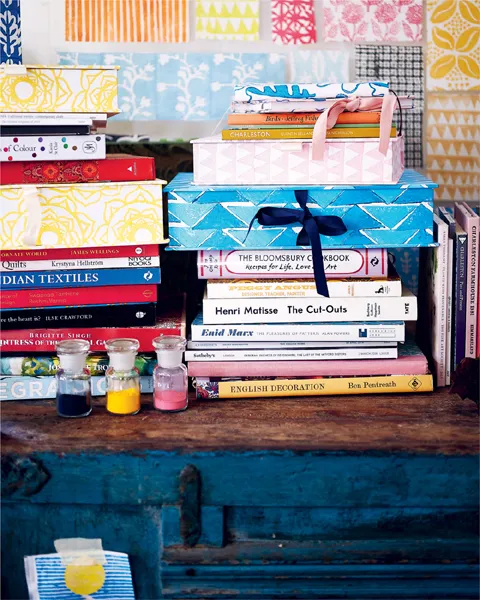
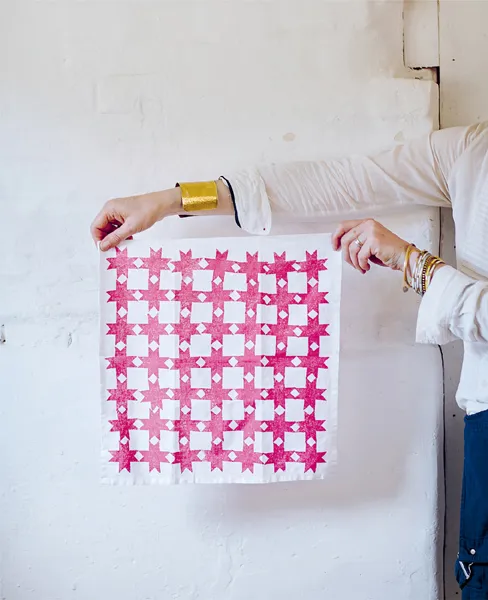
NAPKINS
These napkins were printed using a wooden block made in Jaipur, but you could easily carve a shape like this into lino pre-mounted onto a fibreboard block. The fun of a simple block design like this is that, as the print builds, it creates an additional pattern within the negative area of the design. You could use the same design to make a matching table runner.
table padding
old sheet
plain, hemmed, napkins
masking tape
sheets of wool felt, as required, to create a ‘springy’ printing pad
plastic container with lid
fabric paint
plastic sauce bottle
paintbrushes
wooden block or carved lino pre-mounted onto a fibreboard block
Napkins are washed after every use, so it’s important to pick a quality washable fabric. I bought plain napkins (in a cotton-linen mix), so they were already hemmed and ready for printing.
To create a napkin from a larger piece of material, cut a square of your chosen fabric to the size of the napkin, plus 3cm (1¼in) hem allowance on all sides. Fold and pin a narrow double hem all the way around. Using a sewing machine, stitch the hem to secure it in place – at each corner, stop with the needle down, lift the presser foot, pivot the fabric, then lower the foot and start stitching again. Repeat the process as many times as required until you have the desired number of napkins and are ready to print.
Wash your hemmed napkins at the highest temperature the fabric can take. Once dry, iron out all the creases, lay your napkin flat, then fold it in half horizontally and press a light crease back into the fabric. Lay your napkin flat, then fold in half vertically and press in another light crease. You should be left with a four-piece grid – this will help you find the centre of your napkin and give you four distinct printing areas. When you’re ready to print, follow the instructions overleaf.
Once you have completed your pattern and the fabric is dry, set the paint by giving the napkins a long, gentle press with a dry iron on the highest temperature the fabric can take.
1. Place your hemmed napkin flat over the prepared printing table (see here) and secure. With a small piece of fabric, I often use masking tape to keep it in place as I print, but pins in the corners work just as well. However you choose to secure your fabric, make sure you smooth out any creases as you work.
2. Create a paint tray using a plastic container and wool felt for the printing pad. (Using a container with a lid means you can keep your printing pad sealed in between printings, which will stop the paint drying out.)
3. Pour the paint into the bottle and dilute with water until you achieve a creamy consistency (see here). Shake the bottle well, but remember to keep your finger over the top.
4. Gently squeeze the paint onto the pad and use a paintbrush to create an area slightly larger than your block. Once the paint has soaked into the felt, place the block onto your printing pad, then lift it off the paint.
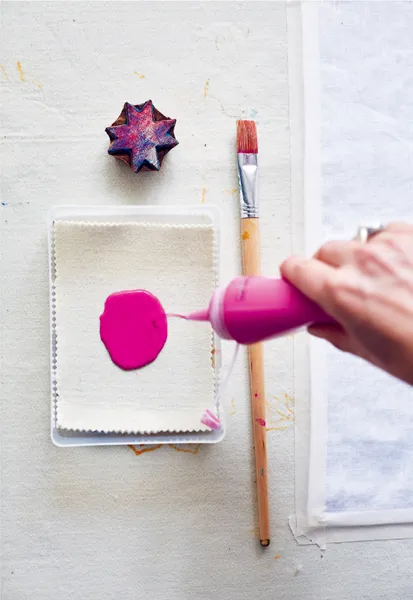
5. Carefully position the block over the centre of your napkin, using the centre point of your creases as a guide, then CONFIDENTLY place it onto the fabric. Give it a good push down. Take a breath and lift the block – do not hesitate! Repeat the process, moving towards the top edge, and loading your block with paint before every print.
6. If you’re right-handed, complete the print within the top left corner of the napkin, then complete the print in the top right corner. Repeat with the bottom corners. (Work in the opposite direction from top to bottom if you are left-handed.)
DESIGN NOTES
As napkins don’t have a natural ‘top’ or ‘bottom’ position, I started printing in the centre of the piece so that I could achieve a symmetrical finish.
I could have continued to print over the sides of the napkin, but here I like how the design is framed by the hem.
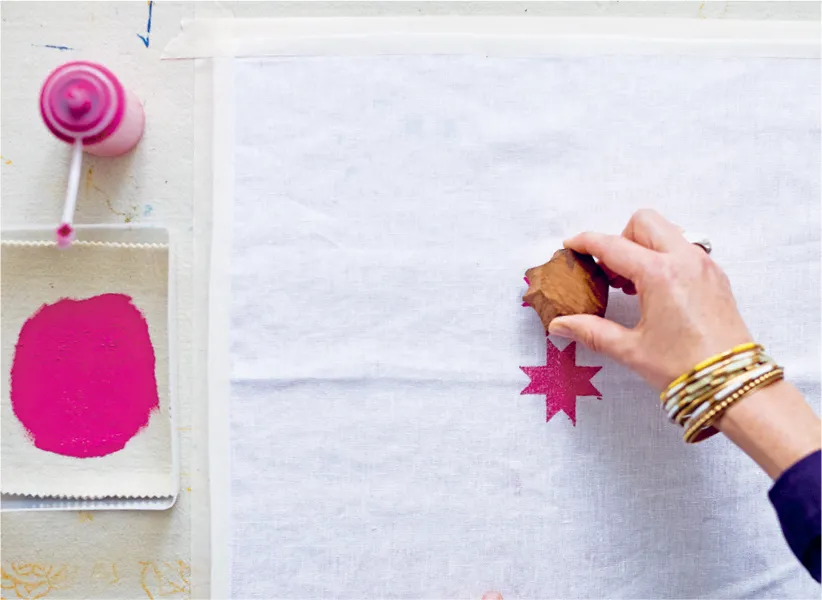
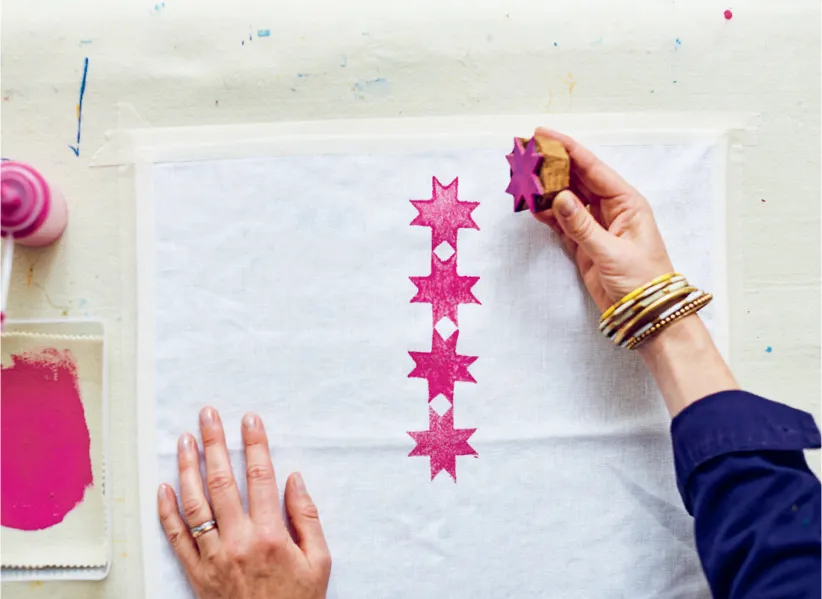
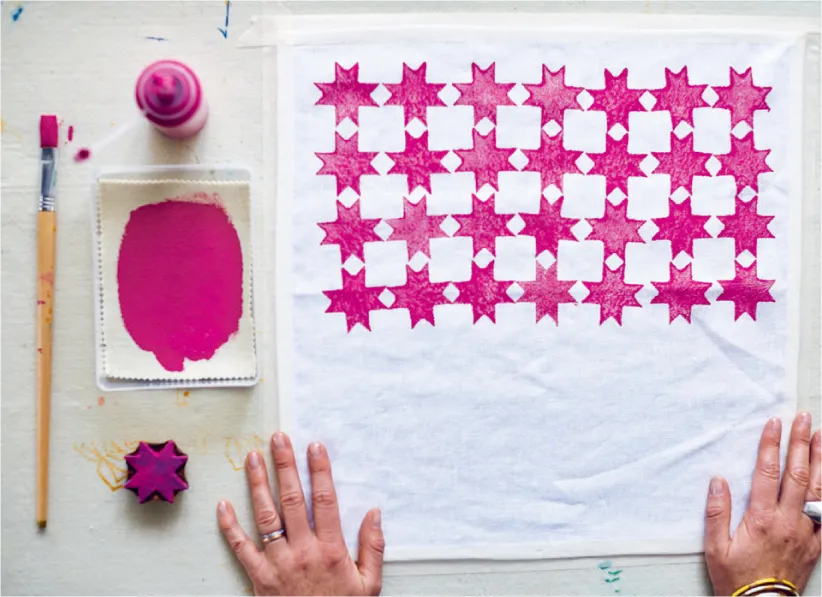
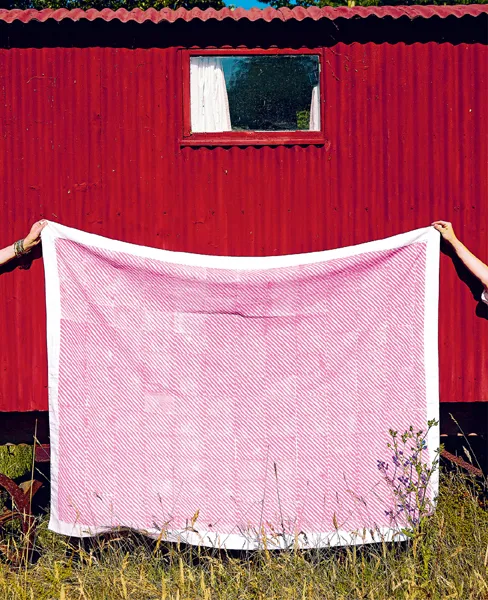
TABLECLOTH
You can easily re-purpose old sheets by printing on them and they make brilliant tablecloths! Alternatively, as I have, buy a plain tablecloth that’s already been hemmed. I carved this design into lino pre-mounted onto a fibreboard block. The very simple stripe comes to life once printed across the expanse of the fabric. If you are concerned about the symmetry of your pattern, you will need to measure the cloth, measure your block, and plan for the best method of fitting the design within the printing area.
table padding
old sheet
plain, hemmed, tablecloth
pins
foam sponge
sheets of wool felt, as required, to create a ‘springy’ printing pad
fabric paint
plastic sauce bottle
paintbrushes
carved lino pre-mounted onto a fibreboard block
Just like napkins, tablecloths might have to cope with a lot of thrills and spills, so make sure you pick a quality washable fabric. Here I bought a plain tablecloth that was hemmed and ready for printing. Alternatively, you can transform an old sheet, or select a plain fabric of your choice.
If you would lik...